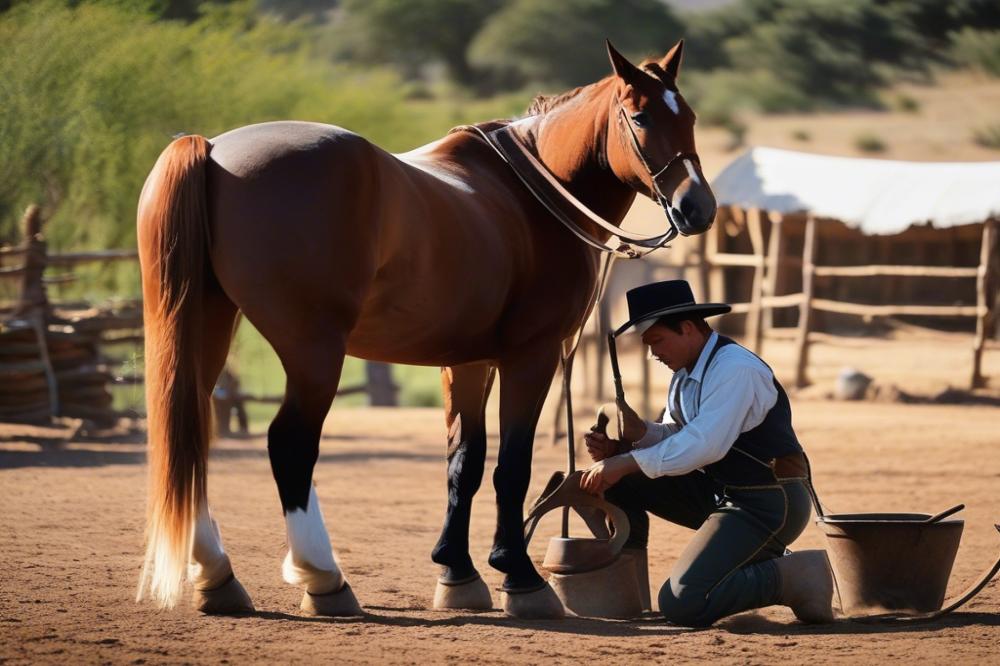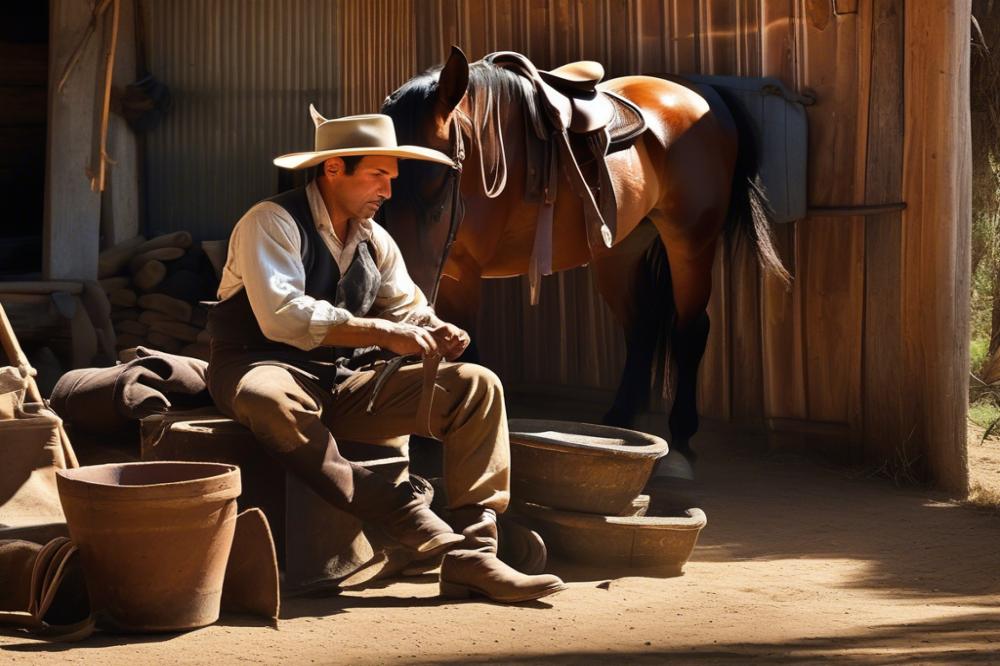Introduction
Horse shoeing in Argentina is much more than just a practical task. It is a tradition steeped in history and culture. The skill of a farrier is respected, with a significant role in the life of every horse that roams the pampas. Proper care of horseshoeing is vital for the well-being of these animals, especially in a land where horses and riders often traverse challenging terrains.
This craft is a crucial part of Argentine identity. gauchos, who embody the spirit of the country’s rural life, have a deep bond with their horses. For these skilled horsemen, fashioning and maintaining horseshoes is not merely functional; it is an art. This connection between the gaucho and his horse runs deep, influencing many aspects of the equestrian culture.
Understanding the gaucho lifestyle helps to appreciate the importance of horse care. These cowboys are known for their distinct attire and skills, often seen rounding up cattle on horseback. The relationship gauchos share with their animals shapes their everyday life. Caring for a horse includes regular shoeing, which is an essential component of their traditions. The knowledge passed down through generations adds layers to this expertise.
Respect for both the horse and the craft of shoeing is evident in rural communities. The farrier’s work is celebrated for its blend of practicality and artistry. Each shoe is tailored to fit the horse perfectly, enhancing performance and comfort. Overall, this reflects a rich culture where every detail matters, ensuring that the legacy of the gauchos and their horses continues to thrive.
The Role of the Farrier in Argentina

The farrier profession holds great significance in Argentina’s horse culture. These skilled artisans provide essential services that contribute to the health and performance of horses, particularly in a country known for its gaucho heritage. A well-trained individual in this field not only shapes and fits shoes but also assesses hoof health. Their work is vital in supporting the equestrian community.
In Argentina, specific techniques in horse shoeing stand out. Traditional methods have been passed down through generations. For instance, gauchos often use handcrafted shoes made from various materials, reflecting local customs and available resources. This approach goes beyond mere functionality; it blends art and utility in every hoof that is shod.
Training for this profession varies. There are no formal schools specifically for farriers in Argentina, although apprenticeships are common. Many learn through hands-on experience, often under the wing of seasoned professionals. Skills develop gradually, encompassing both practical knowledge and artistic flair. A thorough understanding of equine anatomy becomes indispensable.
Body mechanics of the horse guide the processes involved. Shoeing is not merely about adding metal to hooves but requires an eye for detail and an understanding of each horse’s unique needs. Communication is key. Farriers often discuss care with horse owners, ensuring best practices are followed. Collaboration helps identify any potential issues early.
Artistry plays a role throughout the entire process. Each shoe is crafted to fit the specific horse, maximizing comfort and performance. Knowledge of local breeds aids farriers in making informed decisions about shoe design and materials. Such expertise reflects the country’s agricultural background and respect for the ranching tradition.
Gauchos and Their Relationship with Horses

The gaucho is an iconic figure in Argentine culture. These skilled horsemen have deep roots in the country’s rural life. Historically, they roamed the expansive pampas, tending to cattle and horses. Their role has always gone beyond mere herding; gauchos are deeply connected to the animals they care for.
In the life of a gaucho, horses are essential companions. They rely on these animals for transportation, work, and even companionship. This bond requires a commitment to equine health that is paramount in their daily routines. It involves ensuring that each horse remains healthy and ready for the demands of ranching. Truly, a gaucho sees himself as a guardian of his horse’s well-being.
Caring for horses includes various elements, from feeding to grooming. A significant part of this care is the practice of horse shoeing. This skill is vital for the animal’s health and performance. The act of shoeing requires a blend of art and science. Gauchos often learn this craft through generations, embedding knowledge from elders into their daily practices.
Tradition of Craftsmanship and Artisan Skills in Horse Shoeing
This craftsmanship reflects a deep respect for tradition. The skills of a farrier are passed down through the ages, often taught informally on the ranch. Every gaucho takes pride in the process of shoeing a horse, turning it into an art form. Each hoof is unique, requiring individual attention and skill. Mastery of this craft ensures each horse is equipped for the rugged landscape of the plains.
The tools utilized in horse shoeing are just as classic as the technique itself. A forge, hammer, and anvil are staples in a gaucho’s toolkit. Understanding the specific needs of each horse’s hooves leads to better performance and longevity. Many gauchos can quickly diagnose issues with a horse’s feet, showcasing their broad knowledge and expertise.
By merging practical skills with deep-seated traditions, gauchos maintain a vital aspect of Argentina’s rural culture. Through all their work, they uphold the legacy of their ancestors. Their relationship with horses is more than a profession; it’s a monumental part of who they are. Thus, the art of horse shoeing becomes an essential chapter in the story of the gaucho.
Equestrian Traditions and Cultural Heritage
The art of horse shoeing plays a key role in Argentina’s rich equestrian traditions. Horses have always been central to the lives of many Argentines, especially gauchos. These skilled horsemen have a deep connection with their animals. Horses are not just modes of transport; they embody freedom, strength, and a way of life. This connection highlights the importance of maintaining horses, and proper shoeing ensures their well-being.
Culturally, horses are symbols of status and pride. Many families pass down their knowledge of horse care through generations. This heritage enhances the bond between humans and horses. Each horse has its own personality, requiring special attention and care. Whether for ranch work or recreation, the right equipment can make a significant difference.
The Role of Saddles and Other Equipment in Gaucho Culture
Saddles, bridles, and other gear are vital to gauchos. These tools reflect their lifestyle and skills. A well-designed saddle allows for comfort during long hours in the saddle. Tradition dictates the style of gear used, often showcasing local craftsmanship. Many pieces are handmade, adding a personal touch. The craftsmanship of saddlery connects gauchos to their history and the land.
Additionally, decorative elements adorn the equipment, highlighting regional identities. Riders take pride in their gear. Beautifully crafted saddles can be memorable pieces that tell stories of the gaucho’s journey. These items not only serve a practical purpose but also celebrate artistry and tradition.
Through the art of horse shoeing and the importance of equipment, Argentina’s gauchos maintain a rich tapestry of equestrian heritage. This culture reflects the country’s values, history, and the enduring bond between people and horses.
Modern Challenges and Innovations in Horse Shoeing
Current trends in the farrier profession in Argentina reflect a blend of time-honored techniques and new approaches. Many horse owners are now seeking ways to improve hoof care through modern technology. Tools such as digital scanners and 3D printing are becoming more popular. These innovations can help in creating custom shoes that fit perfectly. Incorporating these advancements has proven beneficial for many horses, especially in competitive settings.
Balancing traditional methods with modern practices presents a unique challenge. Skilled artisans, like gauchos, often cling to age-old methods passed down through generations. They rely on their hands and experience in horseback riding and handling livestock. While such traditions hold value, some practitioners recognize the need for change. Adapting to modern practices does not mean abandoning tradition completely. Instead, it can mean combining the best of both worlds for better outcomes.
Challenges arise differently in rural and urban environments. In cities, farriers face stiff competition from large veterinary clinics offering comprehensive hoof care services. These clinics often promote their advanced diagnostic tools. Rural areas, on the other hand, may lack enough resources and training opportunities. Farriers in these settings may not have access to the latest techniques or tools. The struggle often leads to delays in horses receiving proper care. Additionally, economic factors play a role. Many owners may hesitate to invest in higher-quality services due to budget constraints.
Staying informed about current trends is essential for professionals in the field. Ongoing education and workshops can help them hone their skills. Many have started networking with other specialists to share knowledge and strategies. The blend of ancient practices and current knowledge can create more comprehensive care solutions for horses. As both rural and urban contexts evolve, so does the art of horse shoeing in Argentina.
Final Thoughts
Horse shoeing holds a significant place in Argentine culture. It connects the past with the present and plays a role in the everyday lives of both horses and riders. As a vital practice, it showcases the deep bond between the gauchos and their steeds. This relationship is not just practical but steeped in tradition.
Craftsmanship shines through the work of those who specialize in this art. Skills developed over years are evident in each shoe they create and install. Precision matters. Dedicated artisans embody a commitment to quality that directly affects the well-being of horses. Their work protects hooves and contributes to the horse’s overall performance. When well done, it makes a difference.
The gaucho legacy is enduring. These skilled horsemen have shaped Argentina’s equestrian culture for generations. Their influence remains in the fields and ranches where they work. Today, their spirit continues to resonate, inspiring new generations to take pride in this way of life. Equestrian pursuits are alive and well, with respect to both tradition and skill.
In sum, horse shoeing is far more than a technical task in Argentina. It represents a rich tapestry of history, craftsmanship, and unwavering dedication. The relationship between a gaucho and their horse remains a symbol of strength and unity, essential to both culture and community. As time goes on, this practice will likely continue, preserving a vital link to the past while shaping the future.



